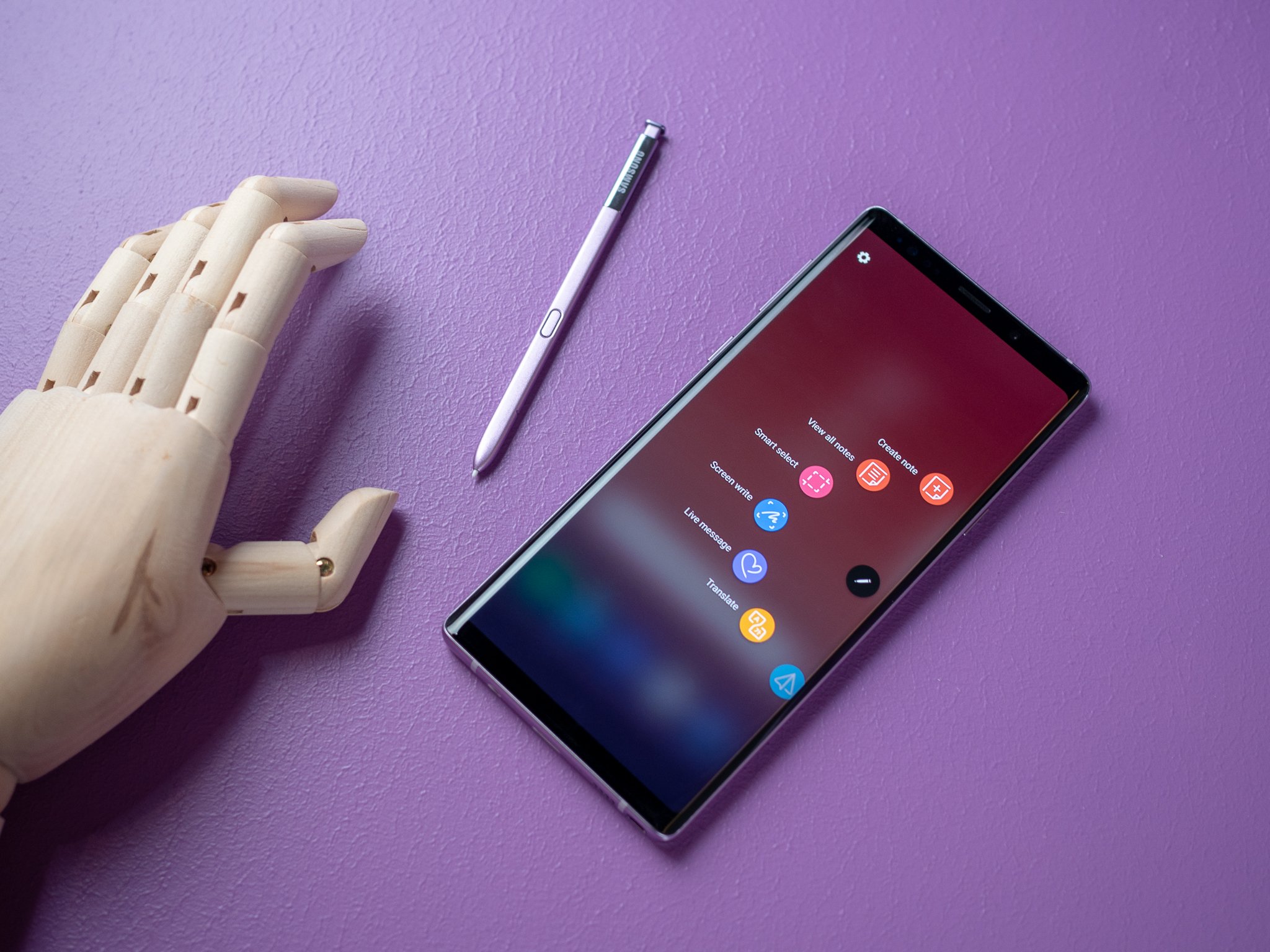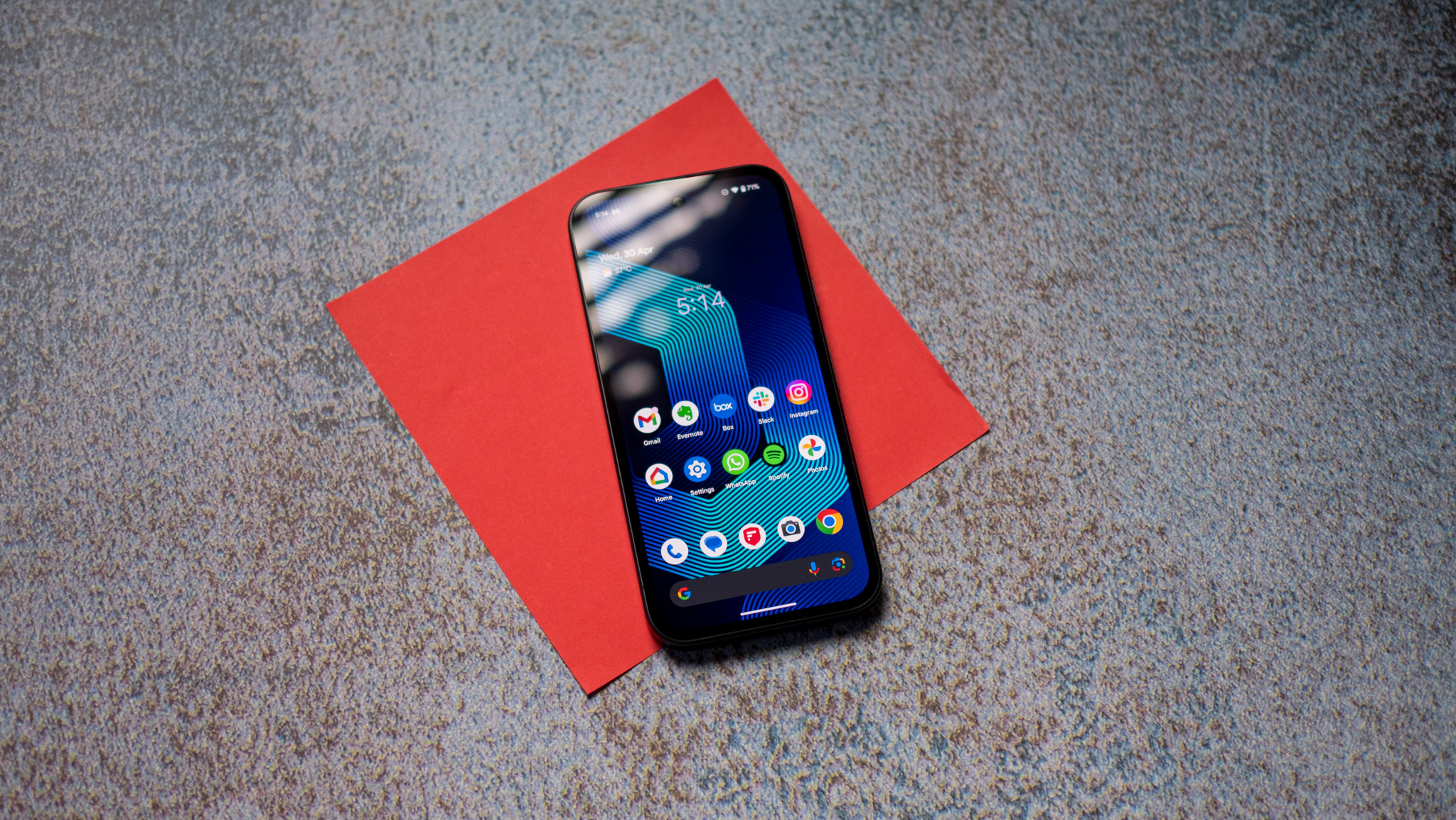Samsung's smartphone philosophy follows one clear path: give customers everything they want, and apply all of the best processes, components and engineering you have in order to do it, no matter the cost. There's no better expression of this philosophy than the Galaxy Note line of phones, which has regularly pushed the envelope of what's "normal" for a smartphone since the original launched in 2011. After a couple generations that didn't set the world alight, Samsung is back at it again with an "everything but the kitchen sink" approach in the Galaxy Note 9.
Given its relatively predictable and methodical step-by-step refresh cycle between the Galaxy S and Galaxy Note phones each year, it's easy to fall into thinking that the Galaxy Note 9 is "just another boring Samsung phone." But to look at Samsung's previous phones doesn't give the Note 9 enough credit for all that it does in a single package — albeit an extremely expensive one. On top of being based on the up-to-this-point best phone Samsung has ever made, the Note 9 added a larger and better display, a bigger battery, a bump up in storage and new S Pen features that continue to be a true differentiator. Here's how it all comes together to make such an excellent phone.
Pros:
- Best screen available today
- Strong battery life
- Beautiful hardware
- Top-notch camera
- Base 128GB storage is great
- Headphone jack
Cons:
- Quick Charge 2.0 isn't fast enough
- That price tag
- Speakers should be better considering size
- Bixby is primarily a punchline
About this review
I've been using a U.S. unlocked Galaxy Note 9 for 8 days, with time split between New York City and Seattle on the Verizon network. The software was version M1AJQ.N960U1UEU1ARG6, with the July 1 security patch, and was not updated during the course of the review. The phone was provided to Android Central by Samsung for review.
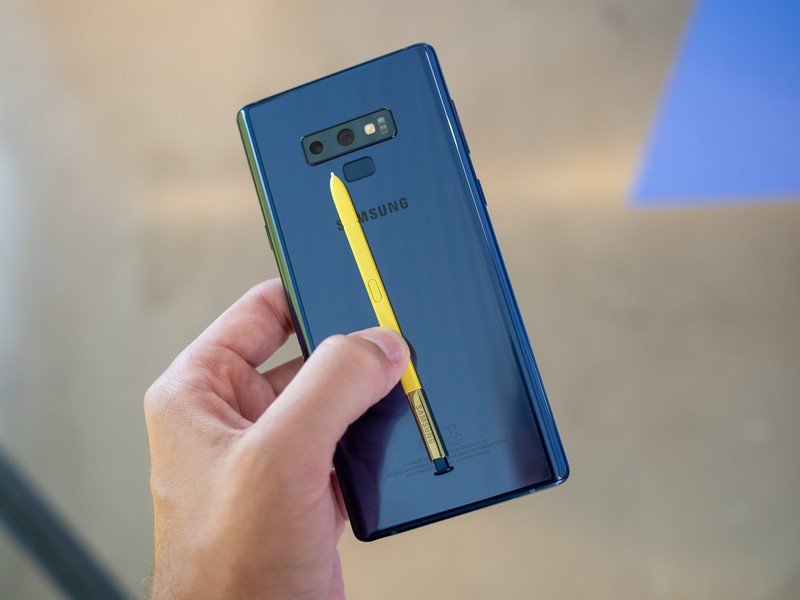
The look and feel
Samsung Galaxy Note 9 Hardware, specs and battery life
At its core, the Galaxy Note 9 is a Galaxy S9+. In terms of basic specs, features, connectivity, capabilities, buttons and ports, the phones are indistinguishable. The Note 9 has the same Snapdragon 845 processor, 6GB of RAM and supporting radios for LTE, Wi-Fi and Bluetooth. It has the same stereo speakers, headphone jack, microSD card slot, USB-C port, buttons and fingerprint sensor. The cameras are entirely identical in terms of hardware. It charges at the same max speed, both wired and wireless. It's water and dust resistant to the same IP68 specification.
Get the latest news from Android Central, your trusted companion in the world of Android
This isn't particularly surprising or even upsetting; the Galaxy S9+ is a wonderful phone with all of the features and power you'd need — and a phone I've been happily using for months — so building the Note 9 from that foundation is great. But it can't be entirely identical, right? Correct, there are some improvements — and they're in areas that will make Note fans swoon.
| Spec | Galaxy Note 9 |
|---|---|
| Operating system | Android 8.1 Oreo Samsung Experience 9.5 |
| Display | 6.4-inch Super AMOLED, 2960x1440 (18.5:9) |
| Processor | Qualcomm Snapdragon 845 |
| Storage | 128/512GB |
| Expandable | MicroSD up to 2TB |
| RAM | 6/8GB |
| Primary rear camera | 12MP Super Speed Dual Pixel, OIS, f/1.5 or f/2.4 |
| Secondary rear camera | 12MP, OIS, f/2.4, telephoto lens |
| Front camera | 8MP, f/1.7, auto focus |
| Connectivity | Wi-Fi 802.11ac MIMO, 1.2Gbps (Cat-18) LTE, Bluetooth 5.0 LE ANT+, NFC, GPS, Glonass |
| Audio | Stereo speakers Dolby Atmos 3.5mm headphone |
| Battery | 4000mAh Non-removable |
| Charging | Quick Charge 2.0 USB-C PD Fast Wireless Charging (15W) |
| Water resistance | IP68 |
| Security | One-touch fingerprint sensor Iris scanner Samsung KNOX |
| Dimensions | 161.9 x 76.4 x 8.8 mm 201g |
| Colors | Ocean Blue, Lavender Purple (U.S.) Midnight Black, Metallic Copper (intl) |
Samsung has finally given the Note a much-needed battery bump — all the way up to 4000mAh, 14% larger than the Galaxy S9+ and 21% larger than the Galaxy Note 8. It always felt a bit odd that the power user-focused Notes have had relatively small batteries, and Samsung has addressed it.
The extra battery capacity has translated directly to battery life that's above-average for the flagship segment and enough for a complete worry-free day of use. Unlike the Note 8, I've been able to end an average day with the Note 9 with roughly 20-25% battery remaining. During my week-long review period I didn't kill its battery before bedtime once, which I certainly couldn't say about the Note 8 or even the Galaxy S9+. That extra 15-20% buffer does wonders for confidence, and it enabled me to use the Note 9 longer in heavier use-case scenarios without worrying that I'd be hitting Power Saving Mode in the early evening.
Samsung isn't making any claim of faster charging speeds, either wireless or wired, despite the increase in battery capacity. It still ships the same Quick Charge 2.0-capable "Adaptive Fast Charging" USB-A wall plug we've seen since the Galaxy S6. But there's more to this story. Thankfully, in my testing the Note 9 pulls a bit more power from this plug than either the Note 8 or Galaxy S9+ — the Note 9 draws about 14.5W from the charger, whereas the Note 8 fluctuates around 13.5-14.5W and the GS9+ fluctuates around 13-14W. The Note 9 also doesn't drop charging wattage when the screen is on, which is something easily observable on the other two phones — perhaps a benefit of its increased heat dissipation technology.
The Note 9's larger battery charges in the same amount of time as the Galaxy S9+.
The result isn't big, but it's notable: the Note 9 charges its larger battery 0-100% in roughly the same amount time (1 hr 40 min) as the Galaxy S9+, give or take a handful of minutes to compensate for heat and phone usage. It's also worth noting that the Note 9 charging at effectively the same rate (0-100%, 1 hr 40 min) from any 15W+ USB-C Power Delivery charger, such as the Google Pixel 2's. Both data points are a relief after being told not to expect a charging speed increase.
I'm still not going to give Samsung a pass for shipping a 4000mAh battery with the maximum capability of Quick Charge 2.0, though. A battery this large in a phone designed for the heaviest users deserves more. Not necessarily in 0-100% charging performance, but in particular with Quick Charge 3.0 and 4.0's ability to rapidly get a battery from 0-30%, which is the most critical charging time for most people.

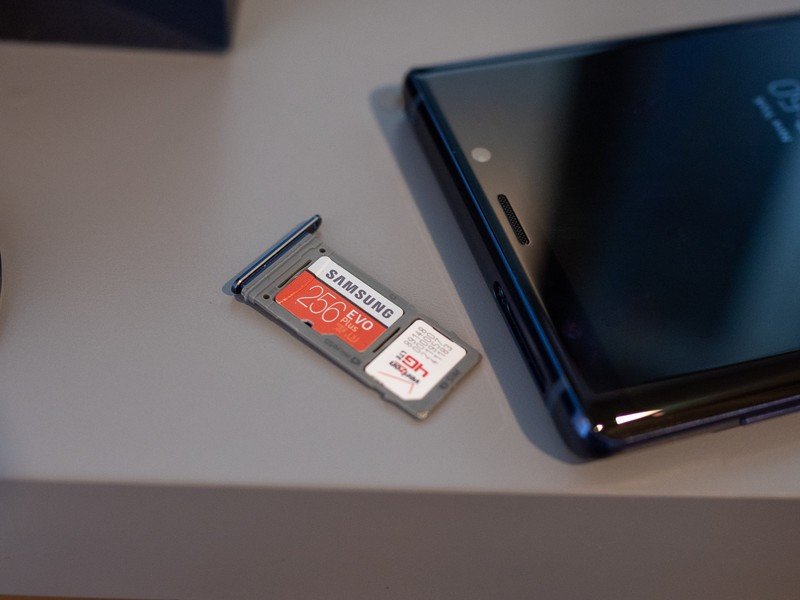
Love storage? The Note 9 has you covered. The base storage for the phone has been doubled to 128GB, which is impressive and a welcomed addition — even for someone like me who rarely pushes the limits of a 64GB phone. With over 100 apps installed, multiple accounts syncing and Pocket Casts downloading several gigabytes of audio, I have 97.5GB free on my 128GB Note 9 without using an SD card — that's plenty.
Most people will be more than happy with 128GB — think twice about that $249 upgrade.
But of course Samsung didn't stop there — you can pay $250 more for a whopping 512GB. And this isn't just some special edition model for certain markets — it's available globally, including from U.S. carriers (except for Sprint, sorry). The 512GB model also makes a bump to 8GB of RAM, which is of dubious value right now (just as it is in the OnePlus 6) but gives you some future-proofing potential, on top of bragging rights. The microSD card slot supports cards of that size (and larger), so with currently available tech you can throw an extra 512GB in the phone for over 1TB of total storage. Even if you want to keep things reasonable (and under $100) and get a 256GB microSD card, that's 768GB of storage ... in your phone. I find it hard to believe anyone needs more than that right now.
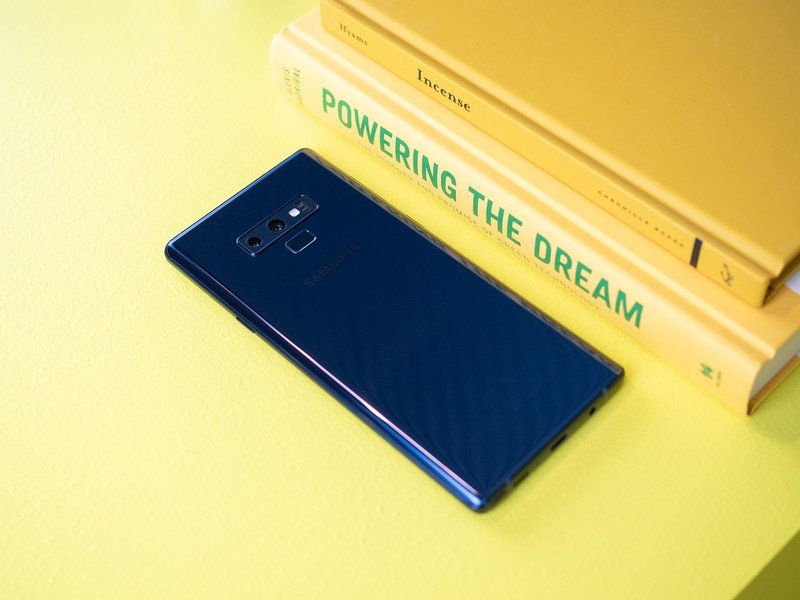
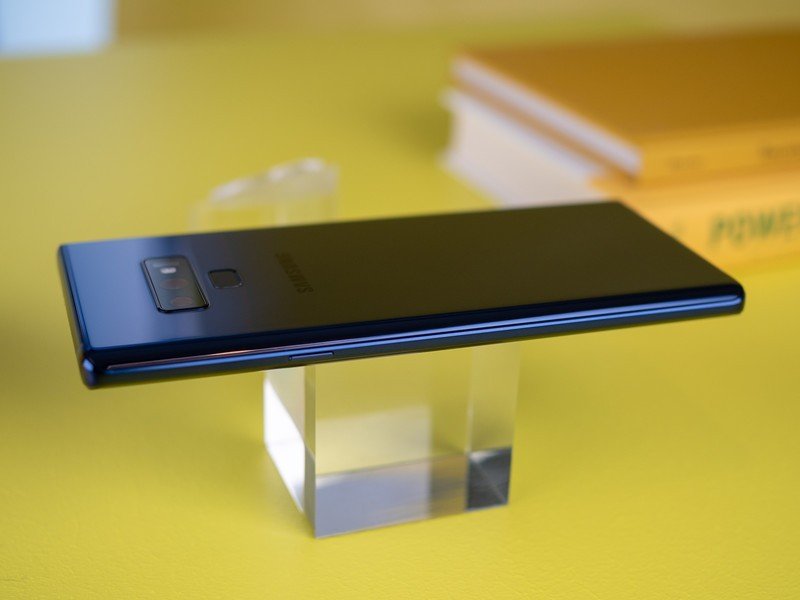
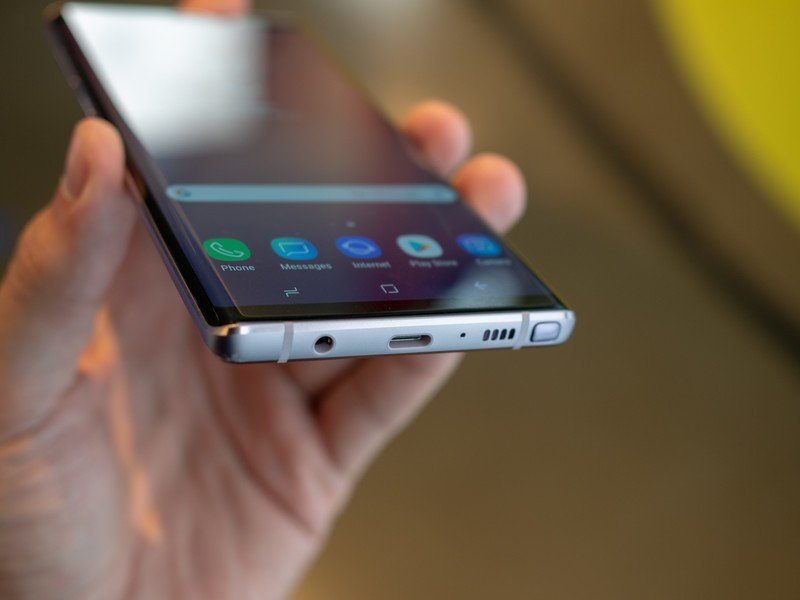
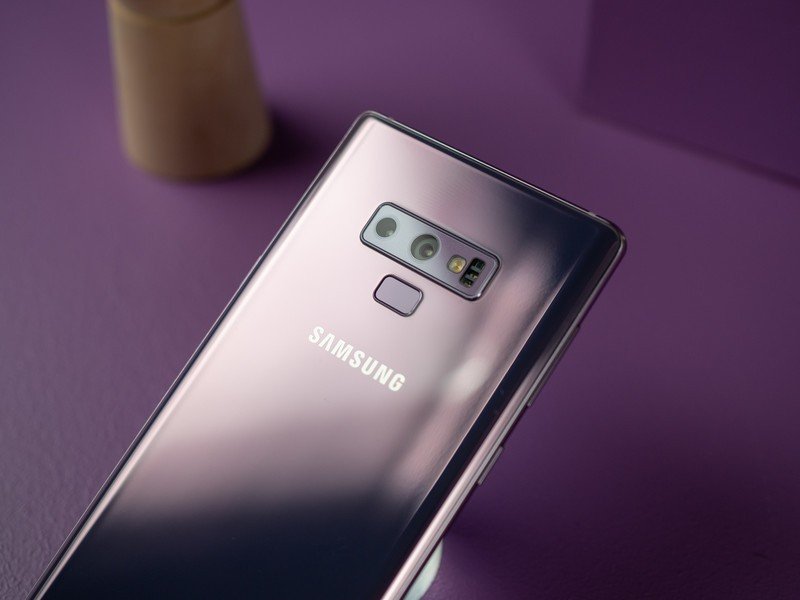
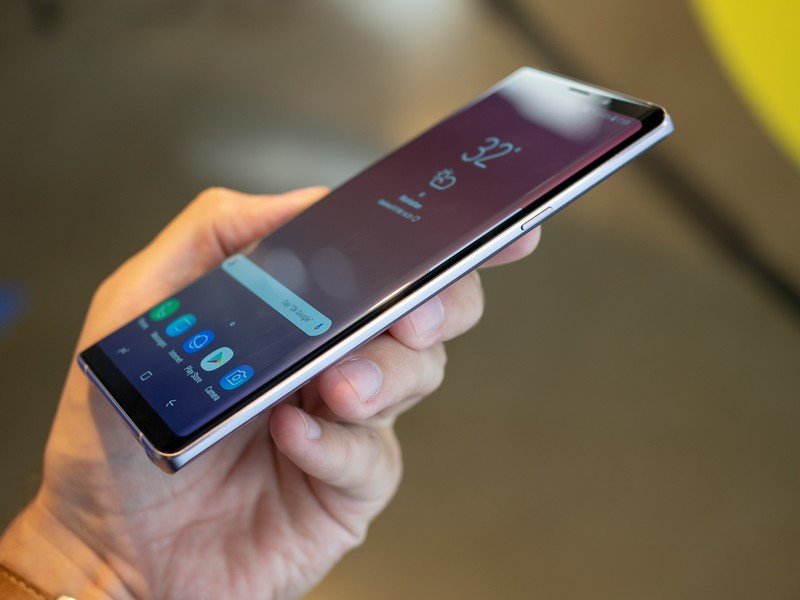
The hardware isn't unique, but it's near-perfect in materials and execution.
Samsung doesn't have much of a story to tell in terms of materials or design this time around. It's no secret that things haven't changed demonstrably since the Galaxy S7, and the Note 9 only makes incredibly subtle changes from the Note 8 and Galaxy S9+. The metal frame has gone back to being a bit more ... metal feeling, with a lightly textured finish and a nicely chamfered edge that makes it stand out and grip a bit easier. But it's still sculpted to flow gently into the curved glass on both sides of the phone. It's big and feels amazing, but it doesn't provide anything new or exciting on the hardware front. That is, unless you count moving the fingerprint sensor to a usable position on the back as "exciting" — I'm glad it moved, but I still can't believe it was anywhere else on the Note 8.
The Note 9 has the best smartphone display ever made.
When you set a Note 9 next to a Note 8 face-up, you can't tell them apart. The Note 9 is imperceptibly wider and thicker, which is a necessity due to the also imperceptibly larger display — now up to 6.4-inches from 6.3, and it's the same 2960x1440 (18.5:9) resolution. The panel itself has received ample improvement across a variety of metrics, though, even though the Note 8 already had the best screen available up to this point. DisplayMate's testing of the Note 9 yielded record-setting scores in several categories and an overall "A+" rating, with absolutely fantastic marks for color accuracy, peak brigthness, color gamut, contrast ratio, screen reflectance, viewing angles and color variation.
The numbers will get the nerds excited, but the Note 9's display really passes the eye test. This screen is fantastic in every situation, and I absolutely love looking at it. DisplayMate used the phrase "visually indistinguishable from perfect" and I can't disagree. Samsung not only bested its own high water mark, but simply furthered its lead ahead of the rest of the industry in display technology.
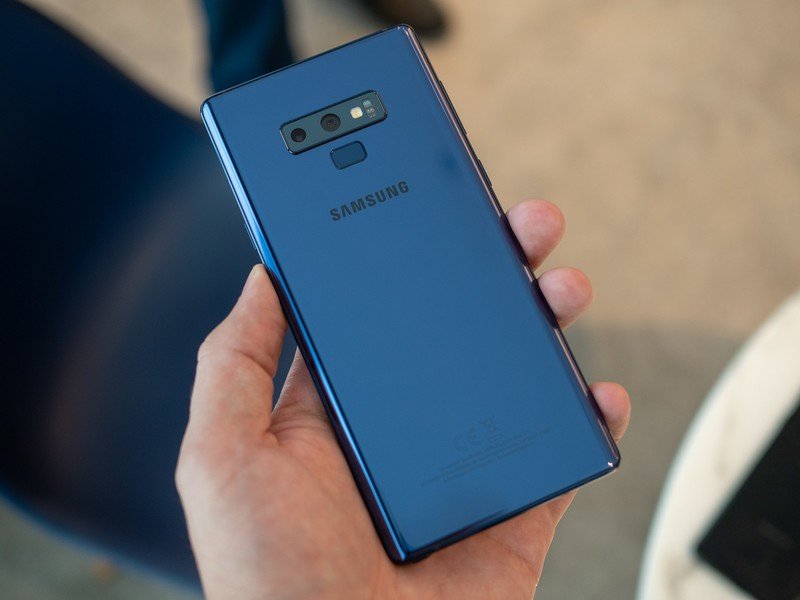
An unfortunate accident
As Happy Gilmore once said, "I didn't break it, I was just testing its durability."
I did have the extremely unfortunate circumstances to test the durability of this metal-and-glass build during my review period. Yes, I dropped my Galaxy Note 9. It slipped out of my hand from about four feet, grazing a concrete wall before landing back-down on the rough concrete floor of my parking garage. Expletives flew as I reached down to pick it up ... and to my surprise, things weren't anywhere near as bad as I expected given the constant commentary about how fragile these glass-backed Samsung phones are.
I feared the worst, but the Note 9 held up to a drop far better than I ever expected.
Two portions of the metal frame have small scuffs where the annodization has worn off — no big deal. Both the top-left and bottom-right corners of the glass have two one-inch cracks. But here's the interesting part: you can't actually feel the cracks with a finger or even the pressure of a fingernail, as they're cracks only on the underside of the glass, not all the way through. They spider out from clear impact points where the glass was pressed to the metal frame, but spread back toward the edges rather than through the middle of the glass. This has undoubtedly compromised the glass to the point where the next major impact will crack the rest of the pane, but I was shocked to see the phone hold up this well to an incredibly gruesome drop onto concrete. Not only did the glass not shatter, you can't even feel the cracks that did form — and the display and all other functions of the phone are in perfect working order.
Best Samsung Galaxy Note 9 Cases
That's not to say that the Note 9 is rugged or robust on the same level as an all-metal device that can take more of a beating — but if you're bold enough to run this thing without a case, it should be able to handle more abuse than you'd think to administer to it. I would never abuse a phone like this on purpose, but given the state of the phones I see around in the wild, many people have done the same as I did this week — I hope their Note 9 survives like mine did.
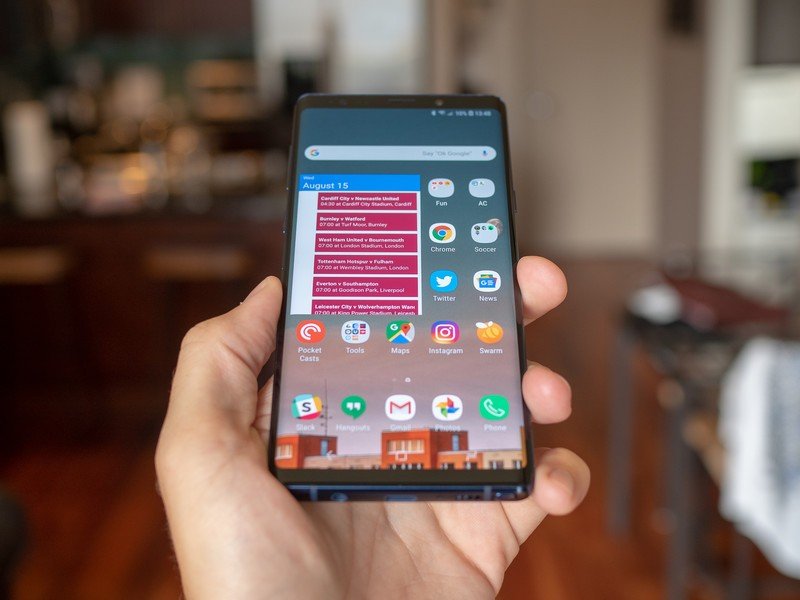
How it works
Samsung Galaxy Note 9 Software, camera and S Pen
The Note 9's settings show a bump up to Android 8.1 Oreo and Samsung Experience 9.5, though you wouldn't know any changes had been made unless you really got into the nitty gritty details with its predecessor beside it. Interface-wise, this is typical Samsung: familiar and powerful to all Samsung owners, and initially frustrating for everyone else. You can argue with Samsung's focus on quantity over quality when it comes to the software, but you can't find fault in the fact that so many people love it and give Samsung little reason to change.
The story is the same on the performance front. It feels odd to praise a $1000 phone for having fluid, consistent performance when that is 100% expected from this level of device, but here we are. The Note 9 is incredibly quick to do everything I ask of it, just like the Galaxy S9+ has continued to over six months of use. I couldn't find anything to make the Note 9 skip a beat, and everything was exactly as fast as I would hope to see from a top-end phone.

An improved S Pen
This is the extra-capable S Pen the Note line deserves, offering far more than just writing and drawing.
The S Pen is the same size and shape as the Note 8's. But it now has a small supercapacitor (effectively a high capacity, low voltage battery) to provide power for a short period so it can connect to the phone over Bluetooth. It provides 30 minutes of connectivity, and up to 250 clicks before it needs to be recharged. But that's nothing to worry about, as it goes from 0 to 100% in just 40 seconds while in the phone — and it remains at 100% so long as it's inside. Even if the S Pen's battery dies, it still works as a writing implement on the screen exactly as it does on previous Notes — with the fantastic pressure sensitivity and tracking so many people love.
I'm a noted S Pen skeptic, coming from the point of view that I simply don't prefer to write instead of type and I'm not at all artistically inclined when it comes to drawing. The Note 9's new Bluetooth-enabled S Pen aims to make this writing implement useful for more than just those areas. And for the limited set of new features it aims to execute, it succeeds.
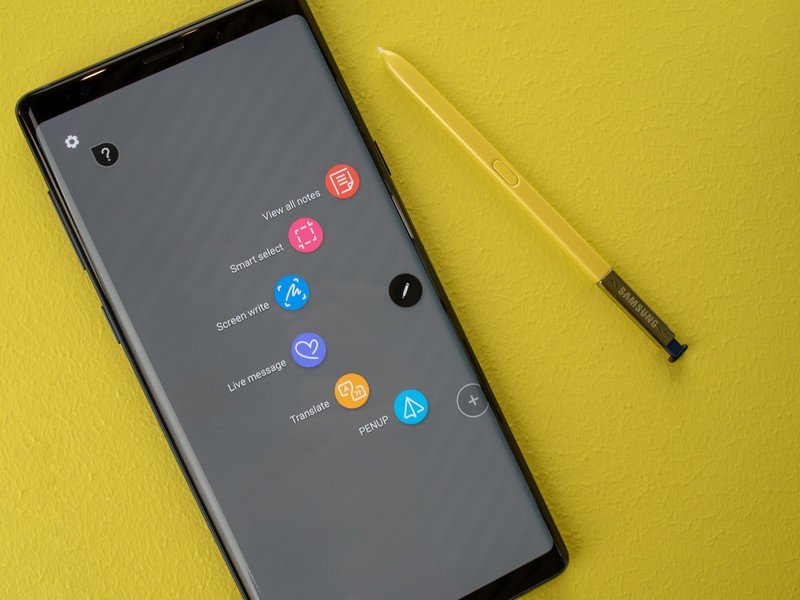
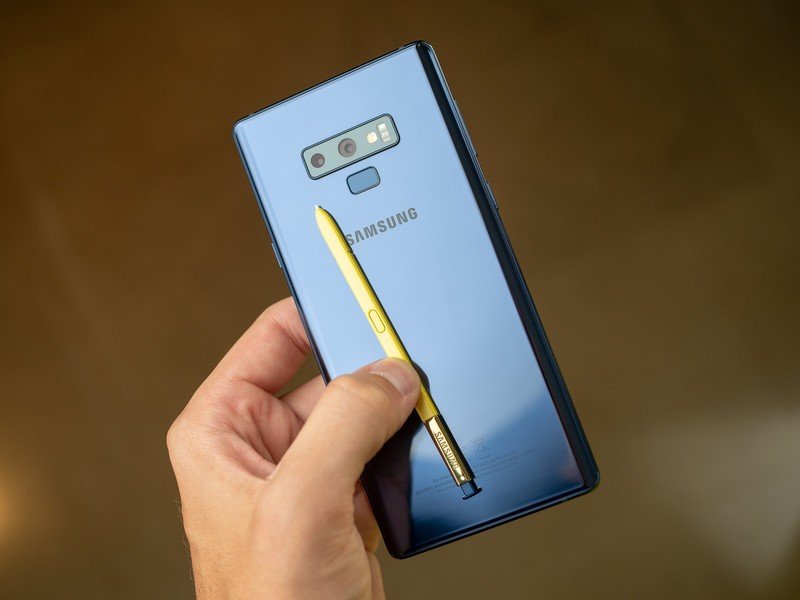
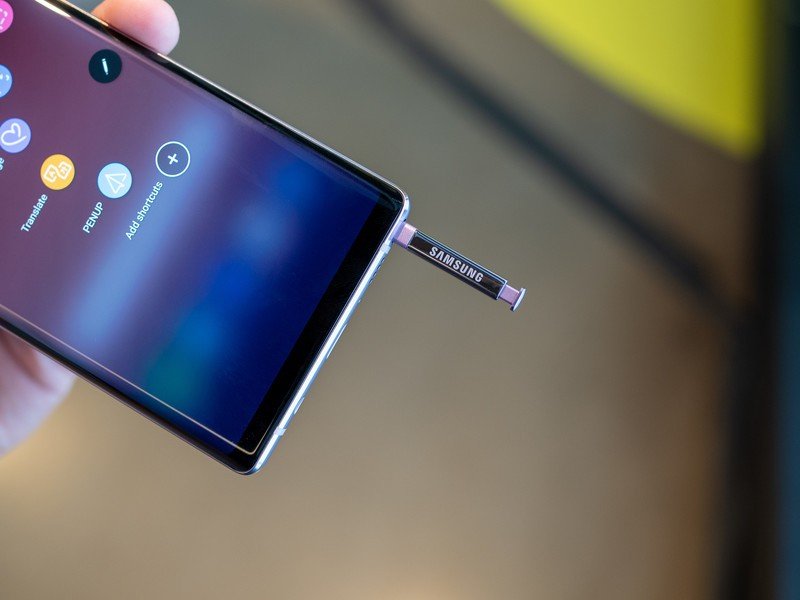
The depth of the interaction is that you can use the S Pen's button to perform specific button-related actions on the phone. A long-press on the button can launch any app, and then depending on the app you can perform additional actions using single- and double-clicks of the button. Samsung has configured several of its built-in apps to work with the S Pen — including PowerPoint, Gallery, Camera, Voice Recorder, media playback and more — and each one offers configurability of 1-4 different actions for both single- and double-click actions. For example in the camera, by default a single click captures a photo while a double-click switches between the front and rear cameras — but you can choose instead to have a single click to capture a photo and a double click to start a video.
I've used the Note 9's S Pen more than any previous Note.
What may end up being its most-used feature is as a media controller. The S Pen's button functions just like a play/pause button does on a pair of Bluetooth headphones, meaning you can easily use it to play, pause and skip tracks in any audio app.
I find it most useful as a camera shutter button when taking either low-light photos (eliminating camera shake by using a tripod or propping up the phone) or selfies (avoiding the "gorilla arm" looking angle). And yes, when I have media playing on my phone while I'm using the S Pen, I like to be able to quickly just hit the button and play/pause the media regardless of what else I'm doing. Then there's the random times here and there when I want to annotate a photo or sign a document — and knowing the S Pen is there for those features is great, saving me from opening a computer.
The S Pen still remains something that you're immediately drawn to, or will never pick up.
But I have to be honest, I'm not doing many PowerPoint presentations nowadays. Nor am I hooking up my phone to a monitor to run photo slideshows. So when you take out just two or three of the available features, you realize this wireless S Pen function didn't add a ton. When you combine a handful of niche use-cases, you don't get a game-changing feature addition ... you get a slightly larger niche.
With this new wireless connection, I used the S Pen more on my Note 9 than I had used on any previous Note just by virtue of having more I could do than just write or draw. That's huge for the Note line's ability to appeal to a wider audience — but this remains something you are either immediately drawn to before buying the Note 9, or you don't get and will never pick up no matter how long you have the phone.
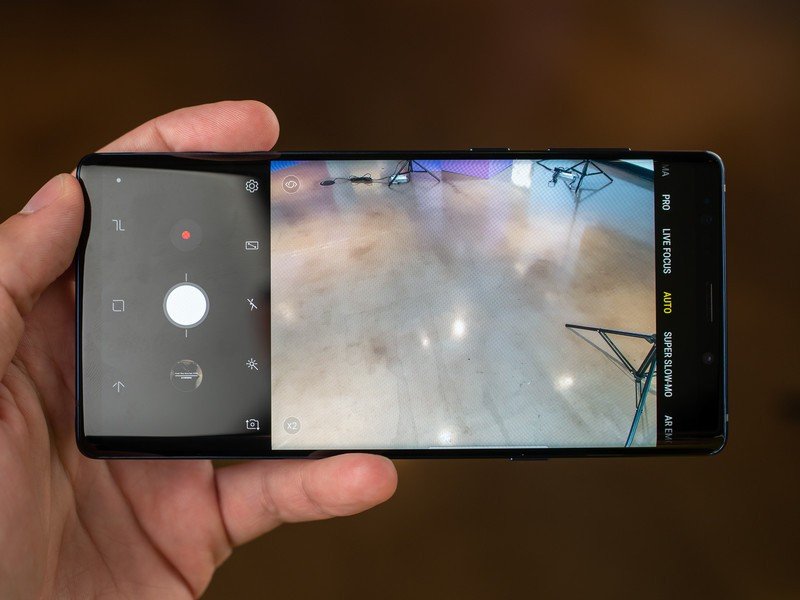
The same (great) cameras
Samsung is talking a big game about the Note 9's cameras, but let's cut through the marketing from the start: they're identical to the Galaxy S9+. The sensors, lenses and hardware support are all the same. Just like the specs discussion above, this isn't a bad thing, but it's worth noting that Samsung hasn't made any hardware upgrades. The only thing that's changed is the software: there are merely two new "AI" camera features called "scene optimizer" and "flaw detection."
Let's cut through the marketing message: the cameras are identical to the Galaxy S9+.
Scene optimizer is a great way for Samsung to put a brand on something it's already doing, cramming in mentions of "artificial intelligence" and "neural networks" for good measure. It runs algorithms that detect features and objects in scenes, and automatically changes camera settings to get you the best possible photo of that scene. It can detect 20 scenes in total, including all of the usual suspects like snow, street scenes, night time, animals, indoors, beach, text, landscape, people, mixed lighting, food, plants, flowers and animals. Scene optimizer is turned on by default and works in the standard auto mode of the camera, and the only indication it's working is a small icon in the interface showing when it recognizes something.
It's difficult to discern the differences between a photo taken with and without scene optimizer.
It's difficult to discern the differences between a photo taken with and without scene optimizer, as Samsung's Auto mode is already fantastic at detecting scenes and choosing the right settings to get the best possible photo. This feature purports to go even further in that customization based on the actual elements of the scene, but I couldn't tell a difference between photos taken with and without it on — nor did I see any difference in quality between the Galaxy S9+ and Note 9 for that matter. This is the type of "smart" camera tech we see in every high end smartphone, and is so often happening behind the scenes anyway — and giving it a brand feels just as forced here as it does on the LG G7 and Huawei P20 Pro.
Flaw detection is legitimately useful with no strings attached. The camera software is trained to detect when it thinks there are major flaws in a photo you just took, including someone blinking, a blurry shot, a smudge on the lens, or poor backlighting. Immediately after taking the photo, you'll get a tooltip telling you that the photo is likely flawed and you should fix the problem and shoot again. This is useful for those quick shots where things aren't thought through perfectly ... and could save you from frustration later when you go to review the messy photo.
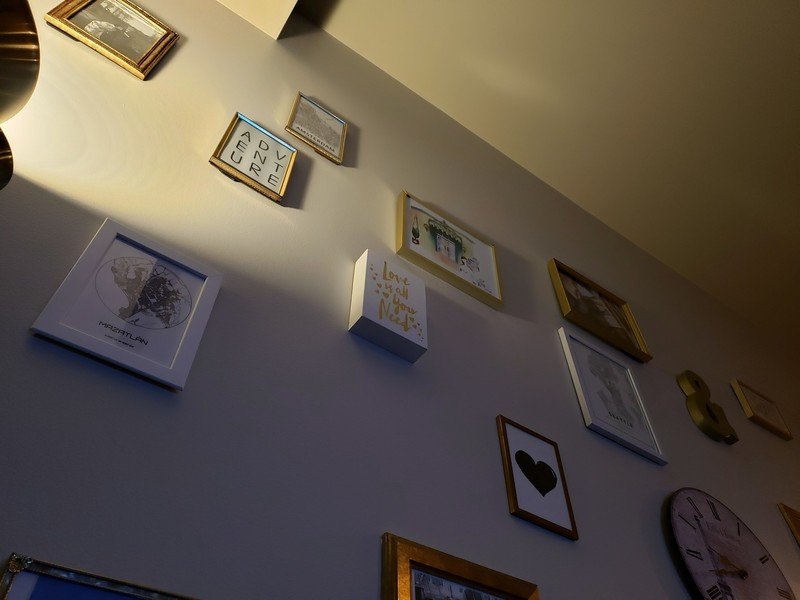






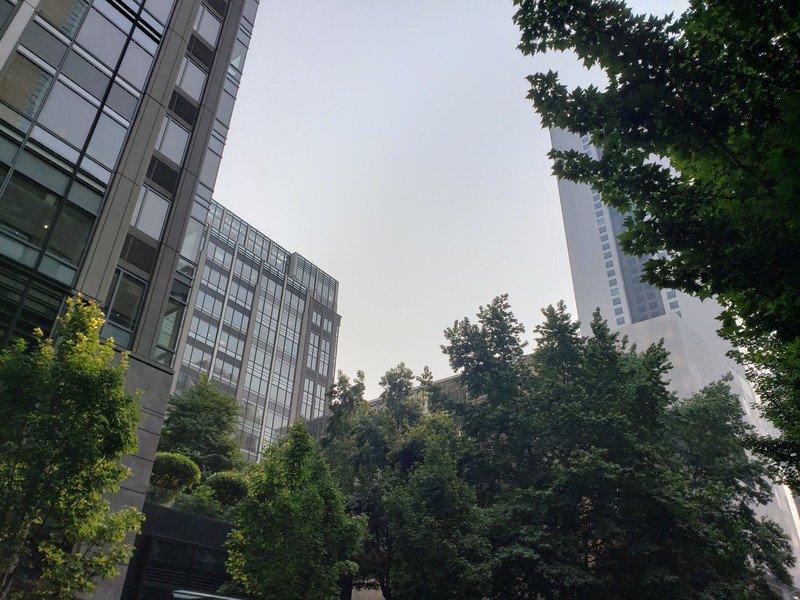



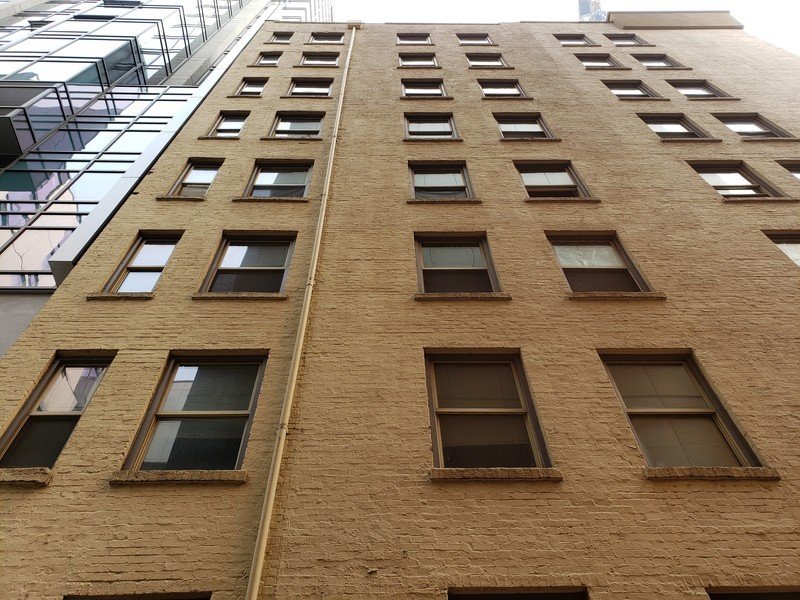

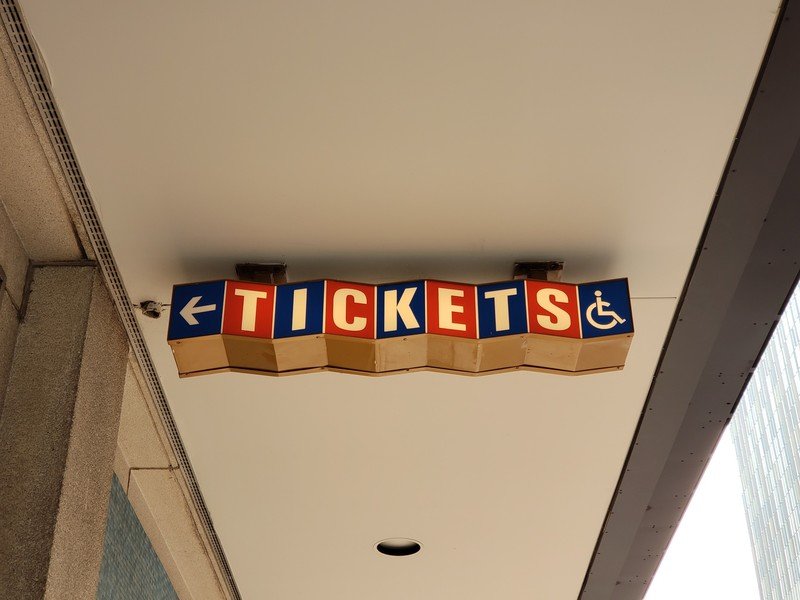
Putting aside the questionable scene optimization, because it doesn't particularly add to the experience, there's tons of praise to be heaped upon the Note 9's cameras. Samsung's biggest strength in photography is that the quality floor is very high — i.e. every photo you take is pretty good no matter the condition or skill level of the photographer. At the same time, it also has a very high ceiling — so if you spend time to compose, tap to focus, or even use Pro mode, you can get amazing photos.
Questionable 'AI' aside, the Note 9's camera is legitimately great for novices and avid photographers.
Samsung has dialed in its colors and dynamic range to the point where you don't really think about whether you need to use HDR, mess with exposure or play with the coloring in post-processing. The shots just look great right out of the camera in Auto mode. And the fine details have been refined to such an amazing extent that you don't see jagged edges or softness even with zooming in for some pixel-peeping.
The low light performance you get out of this primary camera when it switches to f/1.5 aperture is phenomenal, with the same great propensity to have good colors and crisp details even in dim scenes. I do acknowledge that some people don't like the almost over-sharpened look of the photos, and prefer something a bit more "natural" looking with some texture to it, but I don't fault Samsung for taking the approach that offers nighttime photos that look similar to its daylight shots. The secondary camera continues to be useless in low-light shots, where the software chooses to use a 2X digital zoom on the main sensor instead — something you actually see in daylight sometimes as well — but with photos this good from the main camera, even when cropped, it's hard to complain.

The bottom line
Samsung Galaxy Note 9 Review
Galaxy Notes have always represented the pinnacle of Samsung's smartphone capabilities, but up until this point have for some reason been saddled with a couple shortcomings that didn't make them automatic recommendations over the latest Galaxy S. With the Note 9, that has changed — it now has the largest battery of the set, plus more storage across the board and the option for more memory as well. All while packing an even larger, and higher quality, display — and being built on the same spec and feature platform throughout the rest of the phone.
This is the complete package — you just have to swallow that $1000+ price tag.
The Galaxy Note 9 truly does everything better than the Galaxy S9+ does — except, of course, the point of affordability. There's no question that if you want the best phone Samsung makes, you get a Galaxy Note 9 without any hesitation. The only real consideration is whether you see the relatively marginal improvements over the Galaxy S9+ as worth the extra money. The extra battery is a truly useful addition; the extra storage, memory and screen real estate may not be such game-changers for your uses. The S Pen could push you over the top, as it remains unique in the entire smartphone space.
That I'm discussing whether you should by a Galaxy Note 9 or Galaxy S9+ should show you how highly I rate the Note 9 on its core principles to start with. The hardware is gorgeous and surprisingly robust. The spec sheet is bursting at the seams with everything you could ask for. The fundamental Galaxy features throughout the hardware and software are as appealing as they've always been. This is the complete package.
4.5 out of 5
It feels odd to unequivocally say a phone that costs at a minimum $1000 is "worth it" when there are so many other phones out there for a fraction of that. But if any Android phone is worth this one-comma price tag, it's the Galaxy Note 9.

Andrew was an Executive Editor, U.S. at Android Central between 2012 and 2020.
